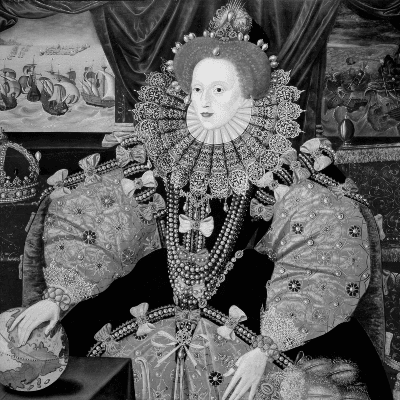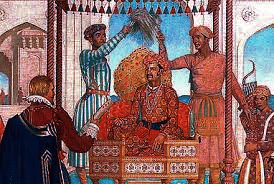UPSC Exam > UPSC Notes > History Optional for UPSC > The English in India
The English in India | History Optional for UPSC PDF Download
Charter of Queen Elizabeth I

- Francis Drake's voyage around the world in 1580 and the English victory over the Spanish Armada in 1588 sparked a new spirit of adventure among the British, inspiring sailors to explore the East.
- As awareness grew about the high profits made by the Portuguese in Eastern trade, English traders also sought to get a share of the lucrative business. In 1599, a group of English merchants known as the 'Merchant Adventurers' established a trading company.
- On December 31, 1600, Queen Elizabeth I granted a charter to the company called the 'Governor and Company of Merchants of London trading into the East Indies,' giving them exclusive trading rights.
- Initially, the company was granted a monopoly for fifteen years, but in May 1609, this was extended indefinitely through a new charter.
- With the Dutch focusing on the East Indies, the English shifted their attention to India, seeking textiles and other valuable commodities for trade.
Progress of the English Company
Foothold in West and South:

- Captain Hawkins arrived at Jahangir's court in April 1609, but his attempt to establish a factory in Surat faced opposition from the Portuguese, leading to his departure from Agra in November 1611.
- In 1611, the English began trading in Masulipatnam on India's southeastern coast, establishing a factory there by 1616.
- Captain Thomas Best defeated the Portuguese off Surat in 1612, impressing Jahangir, who granted the English permission to set up a factory in Surat in early 1613.
- Sir Thomas Roe, an ambassador of James I, visited Jahangir's court in 1615 and secured various privileges, including the right to establish factories in Agra, Ahmedabad, Broach, although he could not finalize a commercial treaty.
- The English company faced challenges from the Portuguese and Dutch initially but benefited from changing circumstances.
- Bombay was gifted to King Charles II by the King of Portugal in 1662, the East India Company received it in 1668.
- Bombay became the headquarters when the Western Presidency moved there from Surat in 1687.
- Tacit peace was established between the English and Portuguese, an Anglo-Dutch compromise allowed the English Company to trade without Dutch interference.
- The 'Golden Farman' from the Sultan of Golconda in 1632 improved the English Company’s position, granting them trading privileges in Golconda ports.
- In 1639, British merchant Francis Day received permission from the ruler of Chandragiri to build a fortified factory at Madras, later Fort St. George, which replaced Masulipatnam as the English headquarters in South India.
Foothold in Bengal:
- Bengal was a large, wealthy province in India, known for its advanced trade and commerce, making it an attractive target for English merchants seeking profit. It was also a crucial part of the Mughal Empire.
- In 1651, Shah Shuja, the subahdar of Bengal, granted the English permission to trade in the region in exchange for an annual payment of Rs 3,000, which covered all duties.
- The English established factories in Bengal at locations such as Hooghly, Kasimbazar, Patna, Rajmahal.
- Despite the privileges granted by the farmans, the Company's business faced obstacles from customs officers who demanded toll payments at local checkposts.
- To address these issues, the Company sought to establish a fortified settlement at Hooghly for potential military protection.
- William Hedges, the first agent and governor of the Company in Bengal, appealed to Shayista Khan, the Mughal governor, in August 1682 for help. When no resolution came, conflicts erupted between the English and the Mughals.
- In 1686, Hooghly was attacked by the Mughal Empire. The English responded by capturing Mughal forts at Thana, raiding Hijli, storming fortifications at Balasore.
- Despite their efforts, the English were forced to abandon Hooghly and were relocated to an unhealthy area at the mouth of the River Ganga.
- After the Mughal attack on Hooghly, Job Charnock, an English agent, negotiated with the Mughals to return to a place called Sutanuti. He signed a treaty in February 1690 and returned to Sutanuti in August of the same year.
- An English factory was established on February 10, 1691, following the issuance of an imperial farman allowing the English to continue their trade in Bengal for an annual payment of Rs 3,000.
- Sobha Singh, a zamindar in Bardhaman district, rebelled, providing the English with a reason to fortify their settlement at Sutanuti in 1696.
- In 1698, the English obtained permission to purchase the zamindari of the villages Sutanuti, Gobindapur, Kalikata (Kalighat) from their owners for Rs 1,200.
- The fortified settlement was named Fort William in 1700, becoming the seat of the eastern presidency (Calcutta) with Sir Charles Eyre as its first president.
Question for The English in IndiaTry yourself: Which event led to the establishment of a fortified settlement at Hooghly by the English East India Company?View Solution
Farrukhsiyar’s Farmans:
- In 1717, an English mission led by John Surman to the court of the Mughal emperor Farrukhsiyar secured three famous farmans, giving the Company many valuable privileges in Bengal, Gujarat, Hyderabad. The farmans thus obtained were regarded as the Magna Carta of the Company.
- Important terms of the farmans:
- Bengal: The Company’s imports and exports were exempted from additional customs duties, except for an annual payment of 3,000 rupees. The Company was allowed to issue dastaks (passes) for the transportation of goods.
- Hyderabad: The Company retained its privilege of freedom from duties in trade and had to pay the prevailing rent only for Madras.
- Surat: For an annual payment of 10,000 rupees, the East India Company was exempted from all duties.
- It was decreed that the coins minted by the Company at Bombay would have currency throughout the Mughal empire.
- The English East India Company secured trading concessions in Bengal through flattery and diplomacy but had to defeat the French to eliminate competition and establish dominance in India.
Question for The English in IndiaTry yourself: What were the privileges granted to the East India Company in Bengal, Hyderabad, and Surat through the farmans obtained from the Mughal emperor Farrukhsiyar?View Solution
The document The English in India | History Optional for UPSC is a part of the UPSC Course History Optional for UPSC.
All you need of UPSC at this link: UPSC
|
367 videos|995 docs
|
FAQs on The English in India - History Optional for UPSC
| 1. What was the significance of Queen Elizabeth I's charter to the English in India? |  |
Ans. The charter granted by Queen Elizabeth I was crucial as it marked the beginning of English commercial interests in India. It allowed the English East India Company to establish trade relations, paving the way for British colonial influence in the Indian subcontinent.
| 2. How did the charter of Queen Elizabeth I impact trade in India? |  |
Ans. The charter facilitated the establishment of trading posts and monopolized trade routes for the English. This not only increased trade volume but also disrupted existing trading systems, allowing the English to dominate the lucrative spice and textile markets.
| 3. What role did the English East India Company play following the charter from Queen Elizabeth I? |  |
Ans. Following the charter, the English East India Company acted as the primary agent of British trade in India. It expanded its operations, secured territories, and eventually played a significant role in the political landscape, leading to British colonial rule over India.
| 4. How did Queen Elizabeth I's charter compare to charters granted by other European powers in India? |  |
Ans. Compared to other European powers, such as the Portuguese and the Dutch, Queen Elizabeth I's charter was significant as it initiated English involvement in India. While the Portuguese had earlier established dominance through military means, the English focused on trade and diplomacy, which gradually led to their political control.
| 5. What were the long-term effects of the charter of Queen Elizabeth I on India? |  |
Ans. The long-term effects included the establishment of British colonial rule, significant economic changes, and social transformations in India. The charter laid the foundation for the English presence in India, which eventually led to the significant exploitation of resources and the impact on local cultures and economies.
Related Searches
















